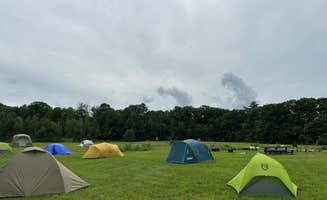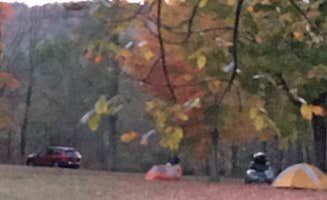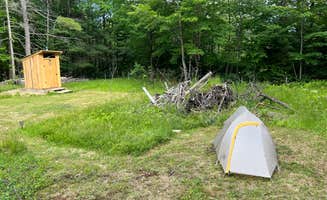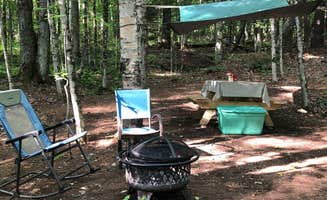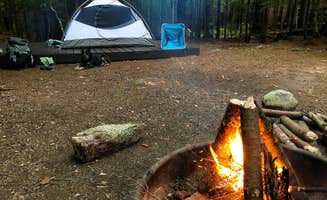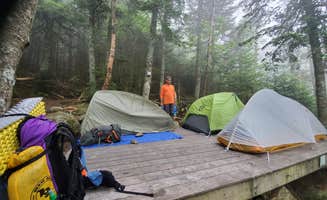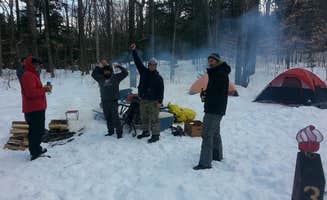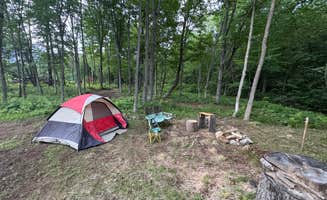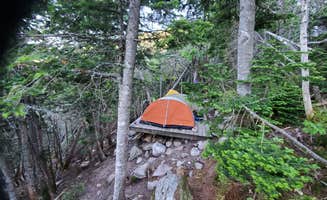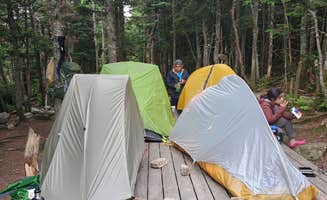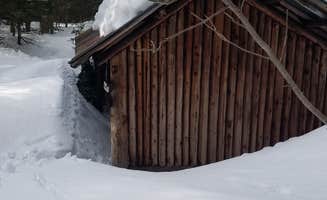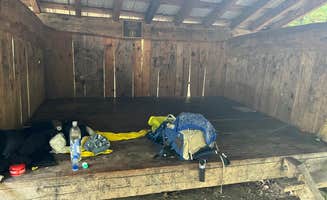Dispersed camping sites near Holderness, New Hampshire offer unique options beyond developed campgrounds with platforms, yurts, and backcountry locations. The area sits at the southern edge of the White Mountains with elevations ranging from 550 to 3,500 feet. Weather patterns can shift quickly, with summer temperatures averaging 70-85°F during the day and dropping to 50-60°F at night.
What to do
River activities: Fourth Iron Campground sits directly on the Saco River with easy water access. As one camper noted, "The water is clear and cold, refreshing on a warm day." The rocky beaches between the sites and river make for excellent swimming spots in summer months.
Winter camping opportunities: Baker Rocks offers year-round accommodations including platforms, cabins and yurts. According to a visitor, "I tent camped here while doing some fishing in the area. Baker Rocks had a host of different camping options onsite including tent platforms, yurts, and cabins."
Mountain climbing: Mount Cardigan provides a challenging but accessible climb for campers. A reviewer at Cardigan Campsites mentioned, "Great spot to spend the night before a climb of Mt. Cardigan! The climb is challenging but shouldn't take too long. Great fire tower views at the top too!"
Fishing excursions: Multiple waterways provide fishing opportunities throughout the region. One camper at Paugus Brook Farm shared, "I stayed here tent camping on the way to some fishing on the Saco River. The location is a great place to either explore the immediate area (Mount Chocorua and Chocorua Lake) or head further north to Conway and North Conway."
What campers like
Private, wooded tent sites: Baker Rocks features secluded tent camping areas. As one visitor described, "The tent sites are within the wooded area around the property and felt very secluded. The facilities here were great. There is a full bathhouse with individual rooms for showers and sink/toilets, with running water."
Unique glamping options: Beyond traditional tent camping, some sites offer alternative accommodations. A Baker Rocks camper shared, "We stayed 2 nights in the double bell tent with two clean full size beds and a 3rd night in the yurt both were spacious and wonderful, among tall trees and pines."
Variety of hiking approaches: Rogers Ledge can be reached through multiple hiking routes. According to a reviewer, "You can access this tentsite from a number of trail heads in northern New Hampshire (Milbrook Trail, Unknown Pond, etc.) for a 3.5 to 5 mile hike in depending on the direction you come."
Abundant wildlife viewing: The region supports diverse wildlife populations. A Rogers Ledge camper noted, "A gradual climb from the trail head to the campsite through a few boggy areas before climbing into the boreal forest for a bit. Prime moose habitat!"
What you should know
Seasonal water availability: Water sources vary by location and time of year. At Sawyer Pond, "Water can be sourced from a small stream that flows from Sawyer Pond to Little Sawyer Pond adjacent to site 1. Be sure to treat all water taken from the pond/stream prior to consuming."
Weekend crowding: The best tent camping near Holderness fills quickly during peak seasons. A Sawyer Pond visitor warned, "Due to the site's popularity, plan accordingly. Have a back-up plan for an alternate camping location. We witnessed several parties, many with young children, arriving late to find that all the sites were occupied."
Train noise: Some camping areas have nearby active rail lines. As one Fourth Iron camper mentioned, "You will cross train tracks to reach the campground and they are active tracks, so you'll hear trains."
Bear precautions: Bear activity requires proper food storage. At Fourth Iron, "This is bear country, so bear boxes are provided." Similarly, at Sawyer Pond, one camper advised to "Plan to hang your food due to bears."
Tips for camping with families
Short hiking options: Some of the best family-friendly tent camping near Holderness requires minimal hiking. At Sawyer Pond, "The hike from the parking lot to the campsite was 1.5 miles and pretty easy. It is mostly flat with a few minor hills (I saw children and elderly folks easily using this trail)."
Easy introductory backpacking: For first-time backpackers with children, certain sites offer manageable experiences. One Sawyer Pond visitor shared, "This is a great beginner backpacking trip, great even for kids! The site has one shelter and 6 campsites available on the bank of Sawyer Pond."
Animal encounters: Some campgrounds feature farm animals. At Baker Rocks, a camper mentioned, "They even have animals to visit like bunnies and goats (far away from the campsites). Do bring bug spray, the mosquitoes at certain times of day were aggressive, as to be expected."
Tent platforms for comfort: Many sites feature raised platforms for easier tent setup with children. At Guyot Shelter, "Approx 10 platform sites. Some are very isolated and some with great views." These platforms keep tents dry and provide flat sleeping surfaces.
Tips from RVers
Alternative accommodations: While most sites near Holderness cater to tent campers, some offer cabin options for those seeking more shelter. Squam Lakes Association maintains boat-in and hike-in sites, with a visitor noting, "We really enjoyed our stay here - we prefer tent camping and like to be secluded; we are not into RV parks."
Limited hookups: Most camping areas near Holderness lack RV hookups. A camper at Fourth Iron Campground mentioned, "You'll need to carry in everything, as parking is on the main road, but this also helps keep away the fair weather campers."
Parking restrictions: Vehicle access varies significantly between sites. At Paugus Brook Farm, "The camping area is a field in the back with fairly level ground and lots of space, and is a very short walk from the designated parking area."


